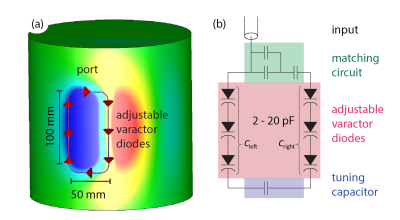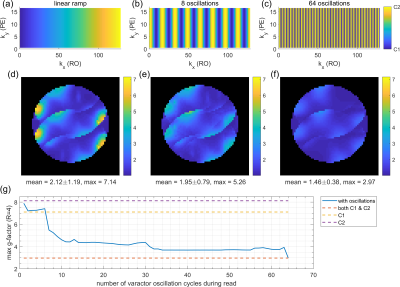Felix Glang1, Kai Buckenmaier1, Jonas Bause1, Alexander Loktyushin1, Nikolai Avdievich1, and Klaus Scheffler1,2
1High-field Magnetic Resonance Center, Max-Planck Institute for Biological Cybernetics, Tübingen, Germany, 2Department of Biomedical Magnetic Resonance, Eberhard Karls University Tübingen, Tübingen, Germany
1High-field Magnetic Resonance Center, Max-Planck Institute for Biological Cybernetics, Tübingen, Germany, 2Department of Biomedical Magnetic Resonance, Eberhard Karls University Tübingen, Tübingen, Germany
Time-varying
receive sensitivities can be achieved by introducing variable capacitance
diodes to the receive loops, which allow to dynamically tune B1-. This offers
an additional degree of freedom for MR image encoding, with the potential for
improved parallel imaging performance.

Figure 1. Schematic
of the proposed receive loop geometry and circuitry. (a) Simulation setup for
one of the four modulatable receive loops placed circumferentially around a
cylindrical phantom. (b) Circuit diagram of the receive loop with tuning and
matching capacitors as well as six adjustable varactor diodes (each in a range
between 2 and 20pF) placed on the long sides of the loop, which are used to
modulate receive sensitivity profiles B1-.

Figure 4. Sensitivity
modulation during readout (RO) of k-space lines. k-space configuration
weightings for (a) linear ramp, (b) 8 and (c) 64 sinusoidal oscillations
between C1 and C2 along each RO line. The latter is equivalent to switching between C1
and C2 for each ADC sample. (d), (e), (f) G-factors for the respective
sensitivity switching patterns. (g) Maximum g-factor for sinusoidal sensitivity
switching versus number of oscillations, compared to static sensitivity sets of
C1, C2 and combined C1 & C2.
